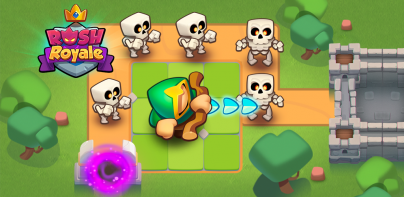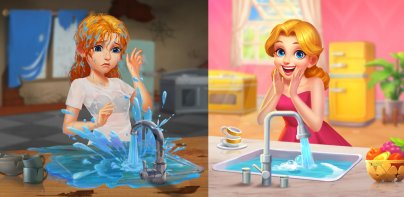


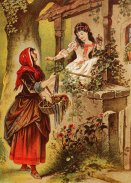
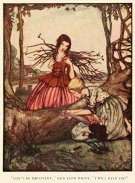

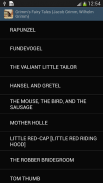
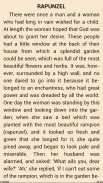
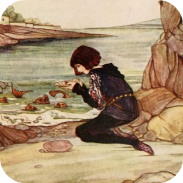
Grimms' Fairy Tales in English

وصف لـGrimms' Fairy Tales in English
Children's and Household Tales (German: Kinder- und Hausmärchen) is a collection of German fairy tales first published in 1812 by the Grimm brothers, Jacob and Wilhelm. The collection is commonly known in the Anglosphere as Grimm's Fairy Tales (German: Grimms Elfenmärchen).
The Brothers Grimm (or Die Gebrüder Grimm), Jacob (1785–1863) and Wilhelm Grimm (1786–1859), were German academics, linguists, cultural researchers, lexicographers and authors who together collected and published folklore. They are among the most well-known storytellers of folk tales, popularizing stories such as "Cinderella" "(Aschenputtel)", "The Frog Prince" ("Der Froschkönig"), "Hansel and Gretel" ("Hänsel und Gretel"), "Rapunzel", "Rumpelstiltskin" ("Rumpelstilzchen"), and "Snow White" ("Schneewittchen"). Their first collection of folk tales, Children's and Household Tales (Kinder- und Hausmärchen), was published in 1812.
The brothers spent their formative years first in the German town of Hanau. Their father's death in 1796, (when Jacob was eleven and Wilhelm ten), caused great poverty for the family and affected the brothers for many years. They both attended the University of Marburg and at the same time developed a curiosity for folklore, which grew into a lifelong dedication to collecting German folk tales.
A fairy tale is a type of short story that typically features European folkloric fantasy characters, such as fairies, goblins, elves, trolls, dwarves, giants, witches, mermaids, or gnomes, and usually magic or enchantments. Fairy tales may be distinguished from other folk narratives such as legends (which generally involve belief in the veracity of the events described)[1] and explicitly moral tales, including beast fables.
In less technical contexts, the term is also used to describe something blessed with unusual happiness, as in "fairy tale ending" (a happy ending) or "fairy tale romance" (though not all fairy tales end happily). Colloquially, a "fairy tale" or "fairy story" can also mean any farfetched story or tall tale; it's used especially of any story that not only isn't true, but couldn't possibly be true.
هي عبارة عن مجموعة من القصص الخيالية الألمانية نشرت لأول مرة في عام 1812 من قبل الاخوة جريم، جاكوب وفيلهلم: الأطفال وحكايات المنزلية (كيندر، اوند Hausmärchen الألمانية). جمع هو المعروف في Anglosphere كما حكايات جريم الجنية (بالألمانية: Grimms Elfenmärchen).
الأخوان جريم (أو يموت GEBRUDER جريم)، يعقوب (1785-1863) وفيلهلم جريم (1786-1859)، كانت الأكاديميين الألمانية، واللغويين، والباحثين الثقافية، مؤلفي المعاجم والمؤلفين الذين جمعت معا، ونشرت الفولكلور. وهم من بين رواة القصص الأكثر شهرة من الحكايات الشعبية، وتعميم قصص مثل "سندريلا" "(Aschenputtel)"، "الأمير الضفدع" ("دير Froschkönig")، "هانسيل وغريتل" ("هانسيل جريتيل اوند") "رابونزيل"، "Rumpelstiltskin" ("Rumpelstilzchen")، و "سنو وايت" ("Schneewittchen"). جمع الأولى من الحكايات الشعبية، وحكايات الأطفال المنزلية (Hausmärchen كيندر، اوند)، ونشرت في عام 1812.
الإخوة أمضى سنوات تكوينهم الأولى في مدينة ألمانية من هاناو. وفاة والدهم في عام 1796، (عندما كان يعقوب أحد عشر ويلهلم عشر)، وتسبب الفقر المدقع للأسرة وأثرت على الإخوة لسنوات عديدة. كلاهما حضر جامعة ماربورغ، وفي الوقت نفسه وضعت الفضول لالفولكلور، والتي نمت في التفاني مدى الحياة لجمع الحكايات الشعبية الألمانية.
حكاية خرافية هو نوع من القصة القصيرة التي عادة ما يتميز الأحرف الأوروبية الفولكلورية الخيال، مثل الجنيات، والعفاريت، والجان، المتصيدون، الأقزام، عمالقة، والسحرة، حوريات البحر، أو التماثيل، والافتتان عادة السحر أو. ويمكن التمييز بين حكايات من القصص الشعبية الأخرى مثل الأساطير (التي تنطوي عموما الاعتقاد في صحة الأحداث التي وصفها) [1] وصراحة الحكايات الأخلاقية، بما في ذلك الخرافات الوحش.
في سياقات فنية أقل، ويستخدم هذا المصطلح أيضا لوصف شيء المباركة مع السعادة غير عادية، كما في "حكاية خرافية تنتهي" (نهاية سعيدة) أو "خرافة رومانسية" (ولكن ليس كل الحكايات تنتهي بسعادة). بالعامية، و "خرافة" أو "قصة خرافية" يمكن أن تعني أيضا أي قصة أو حكاية بعيدة المنال طويل القامة؛ انها تستخدم خصوصا من أي القصة التي ليست فقط غير صحيح، ولكن لا يمكن ان يكون صحيحا.


